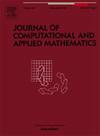A collocation heat polynomials method for one-dimensional inverse Stefan problems
IF 2.1
2区 数学
Q1 MATHEMATICS, APPLIED
Journal of Computational and Applied Mathematics
Pub Date : 2024-11-20
DOI:10.1016/j.cam.2024.116356
引用次数: 0
Abstract
The inverse one-phase Stefan problem in one dimension, aimed at identifying the unknown time-dependent heat flux with a known moving boundary position , is investigated. A previous study (Kassabek et al., 2021) attempted to reconstruct the unknown heat flux using the Variational Heat Polynomials Method (VHPM). In this paper, we develop the Collocation Heat Polynomials Method (CHPM) for the reconstruction of the time-dependent heat flux . This method constructs an approximate solution as a linear combination of heat polynomials, which satisfies the heat equation, with the coefficients determined using the collocation method. To address the resulting ill-posed problem, Tikhonov regularization is applied. As an application, we demonstrate the effectiveness of the method on benchmark problems. Numerical results show that the proposed method accurately reconstructs the time-dependent heat flux , even in the presence of significant noise. The results are also compared with those obtained in Kassabek et al. (2021) using the VHPM.
一维Stefan反问题的搭配热多项式法
研究了一维一维反相Stefan问题,该问题的目的是识别具有已知运动边界位置s(t)的未知随时间变化的热通量P(t)。之前的一项研究(Kassabek et al., 2021)试图使用变分热多项式方法(VHPM)重建未知的热通量P(t)。在本文中,我们提出了配置热多项式法(CHPM)来重建随时间变化的热通量P(t)。该方法构造了满足热方程的热多项式线性组合的近似解,其系数采用配置法确定。为了解决由此产生的不适定问题,应用了吉洪诺夫正则化。作为一个应用,我们证明了该方法在基准问题上的有效性。数值结果表明,即使存在明显的噪声,该方法也能准确地重建随时间变化的热通量P(t)。结果还与Kassabek等人(2021)使用VHPM获得的结果进行了比较。
本文章由计算机程序翻译,如有差异,请以英文原文为准。
求助全文
约1分钟内获得全文
求助全文
来源期刊
CiteScore
5.40
自引率
4.20%
发文量
437
审稿时长
3.0 months
期刊介绍:
The Journal of Computational and Applied Mathematics publishes original papers of high scientific value in all areas of computational and applied mathematics. The main interest of the Journal is in papers that describe and analyze new computational techniques for solving scientific or engineering problems. Also the improved analysis, including the effectiveness and applicability, of existing methods and algorithms is of importance. The computational efficiency (e.g. the convergence, stability, accuracy, ...) should be proved and illustrated by nontrivial numerical examples. Papers describing only variants of existing methods, without adding significant new computational properties are not of interest.
The audience consists of: applied mathematicians, numerical analysts, computational scientists and engineers.

 求助内容:
求助内容: 应助结果提醒方式:
应助结果提醒方式:


